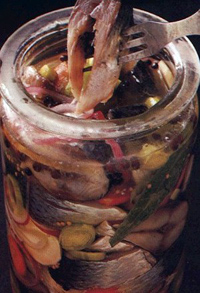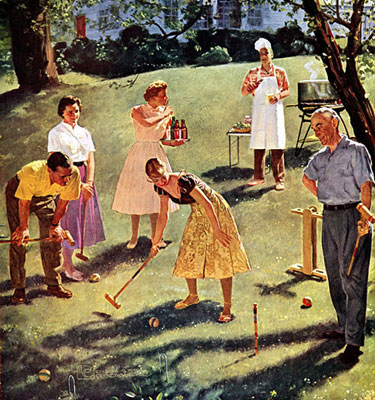From the L.A. Times
 By Thanksgiving weekend, the prep work was well underway. All year long
she'd been saving the boxes from stationery and from her nylon
stockings, stashed with the Christmas ornaments. She'd made lists in
her perfectly inscrutable handwriting. In our basement refrigerator,
she had squirreled away some of the raspberry jam she made during the
summer.
By Thanksgiving weekend, the prep work was well underway. All year long
she'd been saving the boxes from stationery and from her nylon
stockings, stashed with the Christmas ornaments. She'd made lists in
her perfectly inscrutable handwriting. In our basement refrigerator,
she had squirreled away some of the raspberry jam she made during the
summer.
So every fall, when my mom told us that she'd grown
tired of the whole idea of Christmas cookies and was giving them up,
she didn't mean it. We were never sure, though. And we'd whine on cue,
begging her to please at least make the kind we just couldn't live
without -- for me, the Russian tea cakes, for my brother, the spice
cookies called pepparkakor.
But most of her work went on in secret, while we were at school or after we'd gone to bed.
And
by Christmas Eve, we'd have maybe 100 dozen cookies, as many as 20
varieties of exquisite, painstakingly formed cookies, stored in our
freezer.
As a small child, bringing out box after box of
cookies that morning was kind of a miracle. Not quite as wonderful as
Santa, who would get a plate of them that night, but part of the blur
of a holiday full of magic and surprise.

 I was never walked into a temple. Never. Not by my dad, the Jew. I thought being Jewish meant eating lox, bagel & cream cheese in a deli. Because that’s what my dad, the non-religious Jew told me. When we ate at Nate n’ Al’s, he would announce loudly as he seemed to be pointing to the food, “We’re Jews!!!”
I was never walked into a temple. Never. Not by my dad, the Jew. I thought being Jewish meant eating lox, bagel & cream cheese in a deli. Because that’s what my dad, the non-religious Jew told me. When we ate at Nate n’ Al’s, he would announce loudly as he seemed to be pointing to the food, “We’re Jews!!!” Happy Holidays! One of our favorite quick appetizers are these Italian Stuffed Mushrooms. They usually show up on the holiday table because they are so easy to make and serve.
Happy Holidays! One of our favorite quick appetizers are these Italian Stuffed Mushrooms. They usually show up on the holiday table because they are so easy to make and serve. My family, while I grew up in Iowa in the 1970's, had no traditions save one. For 364 dinner days of the year, it was my mother who performed culinary magic at home. (Today her dinners would be heralded by food critics as tempura-style but back then it was just “frying floured foods in fat”.) Her lipid of choice was Crisco but on Christmas Eve the can of Crisco was put away and my father took out the stew pots.
My family, while I grew up in Iowa in the 1970's, had no traditions save one. For 364 dinner days of the year, it was my mother who performed culinary magic at home. (Today her dinners would be heralded by food critics as tempura-style but back then it was just “frying floured foods in fat”.) Her lipid of choice was Crisco but on Christmas Eve the can of Crisco was put away and my father took out the stew pots. I've never been able to understand why Christmas fruitcake is hated so much. What makes it such a dreaded gift, one that gets passed about or relegated to the back of the fridge? I must say I'm not the biggest fan of the cake, some are rather good, but others are just too dense and way too boozey. But this year for Christmas, I was willing to make a better fruitcake. So when a friend suggested I try making the cake from a recipe she loved just to see if I could possibly love it, I decided to give it a wholehearted try. I usually love other cakes that contain dried fruit, so what could be so bad about fruitcakes? And if they turned out better than expected, I'd have something more traditional to hand out as gifts to my fiends and neighbors.
I've never been able to understand why Christmas fruitcake is hated so much. What makes it such a dreaded gift, one that gets passed about or relegated to the back of the fridge? I must say I'm not the biggest fan of the cake, some are rather good, but others are just too dense and way too boozey. But this year for Christmas, I was willing to make a better fruitcake. So when a friend suggested I try making the cake from a recipe she loved just to see if I could possibly love it, I decided to give it a wholehearted try. I usually love other cakes that contain dried fruit, so what could be so bad about fruitcakes? And if they turned out better than expected, I'd have something more traditional to hand out as gifts to my fiends and neighbors.
